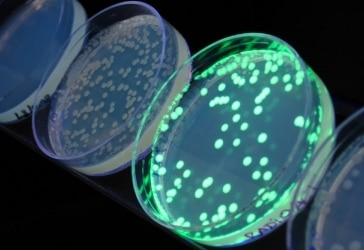In any application that uses antibodies for signal detection (e.g., Western blotting, ELISA, immunohistochemistry, or FACS), there are two approaches to antibody labeling: direct and indirect labeling. Standard Western blotting uses indirect labeling because you use a primary antibody to detect the target antigen, followed by a secondary antibody to which a detection molecule is attached.
In some situations, it may be better to skip the secondary antibody and all associated steps and directly label your primary antibody. Cases that cry out for direct primary antibody labeling include:
- There is unspecific binding of secondary antibody
- You are using non-standard organism primary antibodies – in this case it may be difficult to find good secondary antibodies
- When multiplexing with antibodies that originate from the same species
- When you need to shorten the experimental time by eliminating secondary antibody incubation and associated washing steps
Antibody Parameters
You may label your chosen antibody not only with fluorescent dyes but also with fluorescent proteins, enzymes, and colored particles. All of these are usually attached via a terminal lysine group, so you need to avoid amine-containing buffers (for example, Tris) and molecules throughout all steps. Otherwise, you will mostly label your buffer molecules! You should also avoid the common buffer preservative sodium azide as it will interfere with the labeling reaction.
The antibody for labeling should be at a concentration not less than 0.5 mg/ml and >90% pure. The less interfering proteins and amino-group containing molecules you have in your antibody preparation, the more efficient the labeling reaction will be. But even if your antibody is swimming in glycine and BSA, you can always remove interfering substances by dialysis. You can also improve the purity of your antibody by passing it through an A-protein column or you can even prepare your own affinity purification column with a suitable antigen.
Main In-House Antibody Labeling Methods
1. NHS (Succinimidyl) Ester Method
This method is useful for the conjugation of antibodies with widely available fluorescent dyes such as rhodamine derivatives. It is typically performed in a phosphate buffer with subsequent on-column separation from the unlabeled dye. The main disadvantage is that the esters are unstable because they are moisture-sensitive. The labeled antibody should be used immediately after the end of the reaction.
2. Isothiocyanate Method
You may used this method to make fluorescein isothiocyanate (FITC), which is very popular in the preparation of fluorescent proteins and antibodies. If you’ve worked with fluorescent microscopy, you’ve dealt with FITC. Isothiocyanate analogues of different standard dyes are also available.
Isothiocyanate is more stable than NHS but it is harder to make and your labeling reaction will likely be less efficient with this method. As with NHS, the excess dye should be removed after the reaction by chromatography.
3. Carbodiimide Method
Carbodiimide-derived compounds convert carboxyl groups on proteins into reactive intermediates that can react with lysines. The high reactivity of carbodiimides means that they can be used to label antibodies with relatively inert materials such as magnetic or gold particles. The most commonly used carbodiimide is EDC. NHS is sometimes added to the reaction to aid the formation of relatively stable intermediates.
The method is simple, but similarly to NHS, EDS is hygroscopic, so you will need to use your antibody immediately after labeling.
4. Two-Tag Method
Here, you label your antibody with another protein that serves as a catalyst, for example HRP or alkaline phosphatase. As both of the molecules contain numerous amino-groups, direct cross-linking (as with the NHS method) would lead to polymers of the same molecule. Therefore, you would perform the linking in two separate steps. You cross-link the antibody to molecule X and the catalyst to molecule Y. You need to choose X and Y carefully because they should interact to form the conjugate. For example, you could choose maleimide as X and a thiol as Y.
While the resulting conjugate will more stable that what you obtain with the NHS method, this method will require three times as much work; separate labeling and purification steps for the antibody, catalyst, and the conjugating reaction. The good news is that you can buy pre-labeled catalytic molecule and then label your antibody accordingly.
5. Periodate Method
This method is useful for generation specific HRP-antibody conjugates. Periodate activates HRP by creating aldehyde molecules that interact with lysine residues. The HRP itself has only a few lysine residues, so enzyme polymerization is not a significant concern. The bonds between HRP and the antibody are reversible unless stabilized by adding sodium cyanohydride.
That was my run down of the top home-made antibody labeling methods. There are a lot of commercial kits on the market with similar underlying chemistry that may make your life much easier. If your lab has the money.
Do you have another antibody labeling method that you’d like to share with us? Get in touch by writing in the comments section.
Literature:
Meyer JP, Adumeau P, Lewis JS, Zeglis BM. Click Chemistry and Radiochemistry: The First 10 Years. Bioconjug Chem. (2016) 27(12):2791-2807. doi: 10.1021/acs.bioconjchem.6b00561. Epub 2016 Nov 22.






